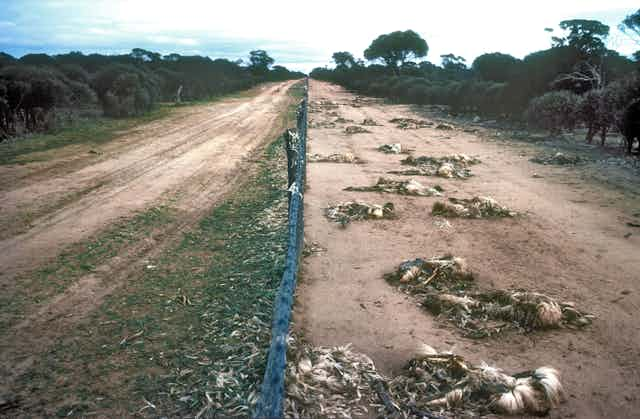Every five or ten years Western Australia’s emus undertake mass migrations in search of food. On the way they encounter the 1,170km State Barrier Fence, which seeks to stop dingos, emus and kangaroos entering farms.
A large proportion of these emus die of starvation, after becoming tangled in the fence, or are shot. The WA Government’s current plan to extend the fence poses even more serious threats to the region’s native plants and animals.
Previously known as the “rabbit-proof fence”, the barrier has failed to stop feral rabbits invading farms. The fence has now been turned against native fauna.
The WA Government plans to build a multi-million dollar, 490km extension of the existing fence, creating a largely continuous barrier through five bioregions from north of Geraldton to Cape Arid.
The extension will cut through the largest intact temperate woodland on earth, the Great Western Woodlands.
The WA Government, under pressure from farmers, will argue they are removing threats to stock and crops. They must also acknowledge however that they are creating another, potentially greater, long-term threat to native flora and fauna.
A key issue here is that there has not been an adequate, transparent cost-benefit analysis. Will there be a net profit from building the fence? A thorough cost-benefit analysis would consider the relative costs and benefits of different ways of solving the problem. It would also consider all of the costs, including the impacts on Australia’s natural heritage.
And the impacts are most likely substantial. A recent report Dr Jenny Lau (Birdlife Australia) and I prepared for the Ecological Society of Australia, the peak group for Australian ecologists, lists three areas where the State Barrier Fence could be undermining natural processes. Peer-reviewed research suggests that the barrier fence is likely to increase fox and cat numbers by excluding dingos, fragment populations of native species and stop seed dispersal.
Emus inadvertently disperse native seeds because they eat fruits from a range of native plants. Emus are estimated to transport seeds from 12 to more than 200 plant species, depending on the region. Emus travel long distances, and by restricting their natural movement the fence is also preventing dispersal of seeds.
In the absence of this dispersal, plant species may decline across large areas. Isolated populations, with no source of replenishment, may die out. This is particularly concerning for the future because many species need to alter their ranges due to global warming. Plants that no longer have the ability to travel long distances inside an emu may not survive accelerating rates of climate change because they cannot keep up with the shifting climate.
Australia needs forward thinking management to sustain natural heritage through climate change. The three consequences of the State Barrier Fence illustrate that the fence is inconsistent with these ideals. We need to enable native species to shift their range to stay within their climatic tolerances. Instead of providing dingo-free space where cats and foxes can flourish, we need to reduce pressures from feral predators so that larger populations of native species survive and have a chance to adapt to climate change.
Unfortunately with this fence, the WA Government is going in the opposite direction.
As it stands, there is certainly enough evidence of important environmental concerns to immediately halt all work on the extension to the State Barrier Fence. The next step is for the WA Government to support a transparent assessment of the costs and benefits of the fence.
My guess is that the costs to farmers of crop damage caused by migrating emus once every five to ten years will be dwarfed by the expense of building and maintaining the fence combined with the cost of the lost ecosystem services provided by migrating emus. Alternative solutions need to be sought.
It is time for the value of Australia’s natural heritage to be fully included in the development equation.

